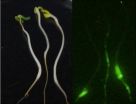(Press-News.org) WEST LAFAYETTE, Ind. - E. coli can live for weeks around the roots of produce plants and transfer to the edible portions, but the threat can be minimized if growers don't harvest too soon, a Purdue University study shows.
Purdue scientists added E. coli to soil through manure application and water treated with manure and showed that the bacteria can survive and are active in the rhizosphere, or the area around the plant roots, of lettuce and radishes. E. coli eventually gets onto the aboveground surfaces of the plants, where it can live for several weeks. Activity in the rhizosphere was observed using a bioluminescent E. coli created by Bruce Applegate that glows when active. Applegate, a co-author on the project, is an associate professor in the food science and biological sciences departments at Purdue.
"E. coli is actually quite active in the rhizosphere. They're eating something there - probably plant exudates," said Ron Turco, a professor of agronomy and co-author of the study published in the November issue of the Journal of Food Protection.
Turco said the E. coli didn't survive on the plants' surfaces more than 40 days after seeds were planted. Harvesting produce at least 40 days after planting should reduce the possibility of contamination, but he warned that E. coli could still come from other sources.
"In actual field application, you pick up other things that are all around," Turco said. "You don't just get the plants that are 40 days old. An animal getting loose in a field could also contaminate plants."
Mussie Habteselassie, Turco's former postdoctoral researcher and now an assistant professor of soil microbiology at the University of Georgia's Griffin campus, said harvesting practices in manure-treated fields can be critical for produce crops.
"If you harvest young and old plants together or mix them after harvesting, there is risk of contamination of the older plants," Habteselassie said. "If plants are uprooted during harvest, there is also a possibility of contamination from E. coli living in the rhizosphere."
Producers should apply manure to fields well in advance of planting and harvesting. Turco said a wait of 90-120 days between manure application and harvesting, with a minimum of 40 days between planting and harvesting, should minimize the chance of E. coli contamination.
Turco said he would continue studying E. coli's ability to survive in different situations, including in water and processed produce. The U.S. Department of Agriculture funded the research.
INFORMATION:
Writer: Brian Wallheimer, 765-496-2050, bwallhei@purdue.edu
Sources: Ron Turco, 765-494-8077, rturco@purdue.edu
Mussie Habteselassie, 770-229-3336, mussieh@uga.edu
PHOTO CAPTION:
Both images show plants grown in an agar substrate with a bioluminescent E. coli, which emits light when active. The E. coli associated with the roots are glowing (right) when viewed in the dark. (Photo provided by Bruce Applegate)
A publication-quality photo is available at http://news.uns.purdue.edu/images/2010/turco-ecoli.jpg
Abstract on the research in this release is available at: http://www.purdue.edu/newsroom/research/2010/101103TurcoEcoli.html
E. coli thrives near plant roots, can contaminate young produce crops
2010-11-04
ELSE PRESS RELEASES FROM THIS DATE:
U of M researcher finds public support for HPV vaccine wanes when linked to controversy
2010-11-04
MINNEAPOLIS / ST. PAUL, Minn. (Nov. 2, 2010) – The vaccine that protects against the potentially cancer-causing human papillomavirus (HPV) enjoys wide support in the medical and public health communities. Yet state laws to require young girls to be vaccinated as a requirement for middle school attendance have aroused controversy with parents, politicians, and even medical and public health experts disagreeing about whether such laws are appropriate. News coverage about HPV vaccine requirements tends to amplify this controversy, possibly leading to negative attitudes among ...
Organic onions, carrots and potatoes do not have higher levels of healthful antioxidants
2010-11-04
With the demand for organically produced food increasing, scientists are reporting new evidence that organically grown onions, carrots, and potatoes generally do not have higher levels of healthful antioxidants and related substances than vegetables grown with traditional fertilizers and pesticides. Their study appears in ACS' bi-weekly Journal of Agricultural and Food Chemistry.
In the study, Pia Knuthsen and colleagues point out that there are many reasons to pay a premium for organic food products. The most important reasons for the popularity of organic food products ...
Built-in timer for improving accuracy of cost saving paper-strip medical tests
2010-11-04
Scientists are reporting the development of a simple, built-in timer intended to improve the accuracy of paper tests and test strips for diagnosing diseases inexpensively at-home and elsewhere. Their study appears in ACS' semi-monthly journal Analytical Chemistry.
Scott Phillips and Hyeran Noh note that so-called point-of-care tests include paper strip tests and others performed at home or bedside instead of in laboratories. They show special promise for improving medical care in developing countries and reducing health care costs elsewhere. When fully developed, these ...
Does adolescent stress lead to mood disorders in adulthood?
2010-11-04
Montreal, November 3, 2010 – Stress may be more hazardous to our mental health than previously believed, according to new research from Concordia University. A series of studies from the institution have found there may be a link between the recent rise in depression rates and the increase of daily stress.
"Major depression has become one of the most pressing health issues in both developing and developed countries," says principal researcher Mark Ellenbogen, a professor at the Concordia Centre for Research in Human Development and a Canada Research Chair in Developmental ...
Electrons get confused
2010-11-04
Scientists from Helmholtz-Zentrum Berlin (HZB) observed exotic behaviour from beryllium oxide (BeO) when they bombarded it with high-speed heavy ions: After being shot in this way, the electrons in the BeO appeared "confused", and seemed to completely forget the material properties of their environment. The researchers' measurements show changes in the electronic structure that can be explained by extremely rapid melting around the firing line of the heavy ions. If this interpretation is correct, then this would have to be the fastest melting ever observed. The researchers ...
Levels of coumarin in cassia cinnamon vary greatly even in bark from the same tree
2010-11-04
A "huge" variation exists in the amounts of coumarin in bark samples of cassia cinnamon from trees growing in Indonesia, scientists are reporting in a new study. That natural ingredient in the spice may carry a theoretical risk of causing liver damage in a small number of sensitive people who consume large amounts of cinnamon. The report appears in ACS' bi-weekly Journal of Agricultural and Food Chemistry.
Friederike Woehrlin and colleagues note that cinnamon is the second most popular spice, next to black pepper, in the United States and Europe. Cinnamon, which comes ...
Small materials poised for big impact in construction
2010-11-04
Bricks, blocks, and steel I-beams — step aside. A new genre of construction materials, made from stuff barely 1/50,000th the width of a human hair, is about to debut in the building of homes, offices, bridges, and other structures. And a new report is highlighting both the potential benefits of these nanomaterials in improving construction materials and the need for guidelines to regulate their use and disposal. The report appears in the monthly journal ACS Nano.
Pedro Alvarez and colleagues note that nanomaterials likely will have a greater impact on the construction ...
Transparent conductive material could lead to power-generating windows
2010-11-04
UPTON, NY - Scientists at the U.S. Department of Energy's (DOE) Brookhaven National Laboratory and Los Alamos National Laboratory have fabricated transparent thin films capable of absorbing light and generating electric charge over a relatively large area. The material, described in the journal Chemistry of Materials, could be used to develop transparent solar panels or even windows that absorb solar energy to generate electricity.
The material consists of a semiconducting polymer doped with carbon-rich fullerenes. Under carefully controlled conditions, the material self-assembles ...
Video-game technology may speed development of new drugs
2010-11-04
Parents may frown upon video games, but the technology used in the wildly popular games is quietly fostering a revolution in speeding the development of new products and potentially life-saving drugs. That's the topic of an article in the current issue of Chemical & Engineering News (C&EN), ACS' weekly newsmagazine.
C&EN Associate Editor Lauren K. Wolf notes that consumer demand for life-like avatars and interactive scenery has pushed computer firms to develop inexpensive yet sophisticated graphics hardware called graphics processing units, or GPUs. The graphical units ...
PET scans reveal estrogen-producing hotspots in human brain
2010-11-04
UPTON, NY - A study at the U.S. Department of Energy's (DOE) Brookhaven National Laboratory has demonstrated that a molecule "tagged" with a radioactive form of carbon can be used to image aromatase, an enzyme responsible for the production of estrogen, in the human brain. The research, published in the November issue of Synapse, also uncovered that the regions of the brain where aromatase is concentrated may be unique to humans.
"The original purpose of the study was to expand our use of this radiotracer, N-methyl-11C vorozole," said Anat Biegon, a Brookhaven neurobiologist. ...




